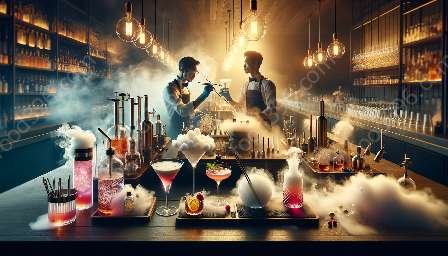Liquid nitrogen has transformed the world of mixology and molecular mixology, offering bartenders and cocktail enthusiasts an exciting new tool for creating innovative and visually stunning drinks. This topic cluster will delve into the science, techniques, and safety considerations of using liquid nitrogen in mixology, providing a comprehensive understanding of this captivating element.
The Science of Liquid Nitrogen
Liquid nitrogen is a colorless, odorless, and extremely cold substance with a boiling point of -196 degrees Celsius (-321 degrees Fahrenheit). It is produced by compressing and cooling gaseous nitrogen, resulting in a liquid state at very low temperatures. This unique characteristic makes liquid nitrogen an ideal ingredient for mixologists seeking to create dramatic effects in their cocktails.
Mixology Techniques Utilizing Liquid Nitrogen
Liquid nitrogen can be used to rapidly freeze ingredients, resulting in a smooth and creamy texture in cocktails. By utilizing this ultra-cold substance, mixologists can create icy garnishes, sorbets, or foams with a striking visual impact. Additionally, the rapid freezing process can preserve the fresh flavors of fruits and herbs, offering a burst of intense taste in each sip.
Molecular Mixology and Liquid Nitrogen
Molecular mixology, which focuses on the use of science and technology to enhance cocktail preparation, perfectly aligns with the unique properties of liquid nitrogen. With its ability to instantly freeze liquids, mixologists can experiment with creating caviar-like spheres, flavored ice creams, and visually stunning smoky effects, adding a touch of theatricality to the drinking experience.
Safety Considerations and Best Practices
While liquid nitrogen opens up a world of creative possibilities in mixology, it is crucial to exercise caution when handling this powerful substance. Bartenders and mixologists must be trained in the proper handling and storage of liquid nitrogen, as it can cause severe frostbite if it comes into contact with skin. Moreover, the proper ventilation and controlled use of liquid nitrogen are essential to prevent the risk of asphyxiation due to the release of nitrogen gas.
Conclusion
Liquid nitrogen has revolutionized the art of mixology, offering endless opportunities for creative expression and innovation. When wielded with knowledge and care, this powerful ingredient can elevate cocktails to a new level of sensory enjoyment, captivating patrons with its breathtaking visual effects and intense flavors.


